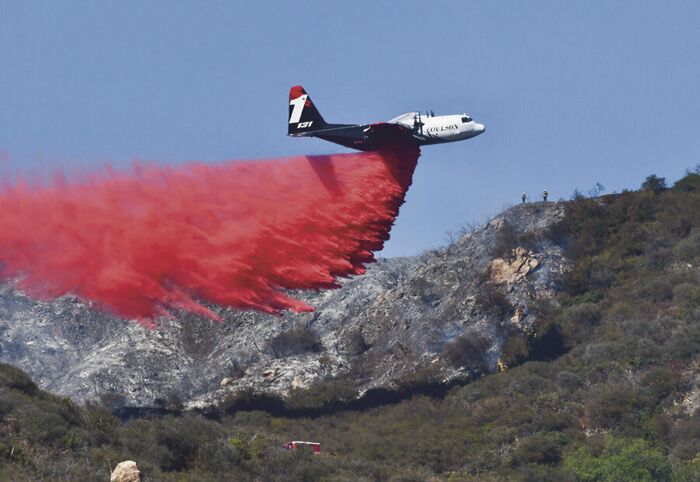
Tons of hot pink Phos-Chek fire retardant were dumped from air tankers in the Malibu area during the Woolsey Fire; tons were also dumped on dozens of other wildfires throughout the state in the time since, including earlier this year during the Flores Fire. Concerned individuals are now raising the question: as Western wildfires become bigger and more intense, and state and federal fire plants use more and more fire retardant, what effect is that having on plants, animals and water quality?
Fire agencies consider aerial wildfire retardants an important tool for protecting communities. The sight of an air tanker dropping up to 8,000 gallons of retardant in front of an approaching fire is usually welcomed by people worried about their homes and businesses.
But the eight-fold increase in areas burned by wildfires since 1985 means there’s also an increase in the amount of fire retardant being dropped. According to the publication Environmental Health News (EHN), the United States Forest Service (USFS) used more than 102 million gallons of retardant from 2012-19 (the latest year records were available).
The primary aerial retardant used, Phos-Chek, developed by the chemical company Monsanto in the early 1960s, is currently manufactured by Perimeter Solutions. It’s about 80 percent water, 10 percent ammonium phosphate and 10 percent proprietary ingredients.
Phos-Chek isn’t sprayed directly on fire—it’s released outside the fire boundary where it lands on vegetation and soil in a sticky film, provides cooling and slows down the fire’s progress. It stays in the environment until removed by the elements.
According to EHN, scientists began raising concerns decades ago about the toxicity of these retardants for wildlife. When pilots have accidentally released retardant over restricted waterways in highly concentrated doses, it’s spurred harmful algae blooms and killed fish, amphibians and other aquatic life.
In 2011, after a court order, a USFS’s environmental impact study concluded that aerial retardant posed minimal risk to most birds and large terrestrial wildlife, like deer, that are able to flee fire, but presented a higher risk to amphibians, rodents, insects and species limited to small geographic areas.
The study also concluded that retardants can adversely affect water quality, especially in small ponds and vernal pools with no flowing water—which are vital to some species in the Santa Monica Mountains
The USFS then set up “exclusion zones” in sensitive areas where retardant wouldn’t be used. Despite restrictions, pilots flying low under challenging conditions have sometimes released retardant into exclusion zones.
As for humans, Phos-Chek cautions that the retardant shouldn’t be ingested and may be a skin, eye and respiratory irritant.
Tim Ingalsbee, a fire ecologist, told EHN that aerial retardant is used wastefully, and that resources should instead be directed towards preventive strategies like prescribed burns, ecological forest management and getting more firefighters.